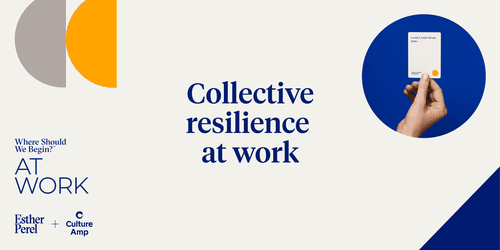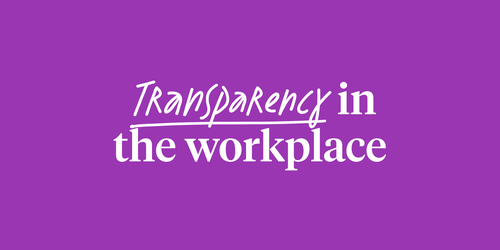
Show me the blueprint: What high-revenue growth companies reveal about performance

Written by

Director of People Science Research, Culture Amp

Senior Data Journalist, Culture Amp
In this blog
In shaky macroeconomic environments, every leader asks: How do we accelerate performance and sustain growth? The instinct is often to look for what’s next – a new market, a cutting-edge product, or a leaner cost structure. Each of these can support a company’s growth, but can also overshadow the powerful impact of company culture and employee experience on performance.
Companies come to Culture Amp seeking a blueprint for success, especially in times of uncertainty. They want to know how to perform better at the individual and organizational levels, boost efficiency, and keep winning.
Once companies start using Culture Amp, they discover the deep connections between sustainable high performance and employee sentiment, growth, and recognition. Companies that crack the code on performance tend to be more successful overall. But those organizations rarely spell out how they did it.
Peeking behind the curtain
At Culture Amp, we used our global employee experience data to uncover that proverbial “secret sauce” and define a blueprint for success. Data analysis helps us answer questions like: What are successful high-growth companies doing differently? What do their blueprints have in common that other companies may be missing?
The Inc. 5000 list highlights North America’s fastest-growing private companies, so we took a closer look at the Culture Amp customers on that list. Over the last five years, Inc. has recognized Culture Amp customers 599 times. To qualify for the Inc. 5000 list, these companies had to grow dramatically over three years. And to stay on the list? They had to sustain that growth over time.
For this study, we looked specifically at the 174 companies that made the list in 2024. We compared them to a group of similarly sized and similarly placed companies – a control group. Companies in the control group are also growing and investing in company culture, so this study set out to understand what moves the needle from good to great.
What we found points to a foundational element of company culture that’s often overlooked and sometimes even avoided: accountability.
Accountability is the foundation of sustainable high performance
Being held accountable can make people uncomfortable, and seeing others disciplined for falling short isn’t exactly fun either. But accountability is essential at work, in relationships, and beyond. That said, we didn’t anticipate just how foundational it would prove to be to business outcomes.
Our data showed that accountability is precisely where the best companies excel. Compared to employees at companies in the control group, employees at Inc. 5000 companies have a significantly higher perception of accountability, recognition, and leaders.
At a company where accountability is deeply woven into the culture, employees are likely to feel a sense of ownership in their work. When expectations are clear, outcomes are measured, and there’s little room to let things slide, employees naturally hold themselves and others to a higher standard.
A higher standard intuitively leads to more recognition. An atmosphere with high accountability, where leaders and peers regularly recognize the small wins hidden in their day-to-day work, builds trust and reinforces that everyone’s contributions matter.
In a workplace culture that values recognition, employees will feel seen for what they accomplish, supported to reach higher when they fall short, and motivated to keep up with peers. The combination of high accountability and recognition fuels performance and a shared sense of purpose.
Companies that sustain high revenue growth are better at communication
As part of our study, we compared companies that have stayed on the list with those that were on it but dropped off. We found that employees at companies that remain on the list had a significantly higher perception of two-way communication, accountability, and focus on quality.
Two-way communication signals that leaders actively listen, respond, and incorporate employee feedback into their work, just as employees are expected to improve their performance following feedback from leaders. This feedback loop makes teams feel they’re moving in sync and pulling toward the same destination.
Prioritizing quality does something similar. It takes accountability and turns it into a shared pursuit of excellence. It shapes habits and drives continuous improvement, so one win sets the stage for the next.
Our analysis revealed a direct correlation between elevated accountability and sustained revenue growth. Communication and quality make accountability stick, turning one-off victories into sustained high performance.
Accountability impacts the bottom line
Because Inc.’s rigorous evaluation process considers revenue growth over three years, we performed a simple regression, plotting a company’s favorability in 2022 (year two) on each question to their three-year revenue growth reported by Inc.
Across our database of questions, 12 were significant. And one of those twelve was about, you guessed it, accountability.
When teams are clear on what they’re responsible for and feel supported in meeting those expectations, they tend to execute better. Over time, that kind of clarity and follow-through shows up in the numbers. For leaders, it’s a reminder that how you set expectations and hold to them can shape your team and company’s growth trajectory.
Anatomy of accountability
As many of us have experienced, accountability can go sideways if it feels punitive. When it’s not done well, accountability can resemble a reprimand rather than a supportive strategy to help teams effectively manage workloads and achieve excellence. How accountability is practiced bears an impact on the way employees perceive it.
To understand the anatomy of accountability, we conducted three qualitative interviews with companies that use Culture Amp and were also on the Inc. 5000 list in 2024. In those conversations, we learned three things about accountability that seemed unique.
1. Accountability starts before underperformance occurs – at goal setting.
The first step in accountability is establishing clear organizational goals that ladder down to individual employees and setting expectations to meet those goals.
Heather Senkunda, Senior Director, HR Business Partner at Boomi, says:
“We cascade goals using very specific processes. Ultimately, it allows people to feel like they are connected to Boomi's objectives and success at the end of the year. It allows them to have direction and prioritization of their own work, and as things come along, to know how this is driving the business forward. Is this meeting the objectives that are tied to my manager and their manager and their manager all the way up the line? It allows us to focus with intention on what we're doing.”
2. Employees need more than one touchpoint to know how they’re doing.
Build accountability into the structure and mechanisms of feedback around them.
Noelle Banks, Director of People Experience, Talent, and Organizational Development at ID.me, says:
“We wanted our mid-year performance check-in to be a lightweight and seamless process between formal performance reviews. We wanted to improve communication and build management capabilities. I had to fight for this, and we got it. We wanted to give our employees an anchor for regular conversations that could fit within our busy culture and still address the need for clearer management practices within the organization.”
In our research on individual performance, we found that high-performing employees are more satisfied with the feedback they get from their managers and that they’re uniquely motivated by constructive feedback. High-quality feedback is business-critical, especially for organizations focused on building sustainable high-performance cultures.
3. Accountability comes from the top.
Holding people accountable is everyone’s responsibility, especially leaders.
Dean Carpenter, VP Global Talent Practices at MRI Software, says:
“We empower leaders first and foremost. We don’t believe accountability should be outsourced to HR - it’s a leadership behavior. If a leader isn’t holding their team accountable, that’s a performance issue in itself. And that’s something the leader needs to be held accountable for, too.”
We know from previous research that how leaders perform influences the way their direct reports perform, and that employees mimic the behaviors they see in their managers. Leaders are uniquely positioned to set the bar when it comes to accountability in performance.
Moving from concept to operation
Beyond performance processes, what does operationalizing accountability actually look like?
For answers, we conducted a latent profile analysis, a statistical method used to identify subgroups within a population based on their responses to a set of observed variables (factors across engagement surveys).
We included factors we know impact the employee experience, namely: leadership, alignment, feedback, development, enablement, and engagement. For the data nerds out there, we used Z-score to effectively standardize the factors.
Our analysis characterized companies within the Inc. 5000 and control groups, revealing distinct cultural profiles.
One such cultural profile, which we termed "Cultural Powerhouse," is made up of companies performing meaningfully above average (approximately one standard deviation above average) across every factor we tested.
Being on the Inc. 5000 list is a sign that a company could be a cultural powerhouse
Our analysis showed that Inc. 5000 companies are more likely to fall into this "Cultural Powerhouse" category than companies in the control group.
Further analysis of each distinct cultural profile showed that development and feedback were the areas where top companies excelled most and where below-average profiles struggled the least.
Feedback and development are critical elements of accountability
Feedback is a cornerstone of accountability. It's how information about performance is shared and delivered, giving employees the opportunity to adjust and improve. Similarly, development is an employee's plan to grow and improve within the company. When opportunities for advancement are clear, employees are more likely to go beyond the basic obligations of their role and push to exceed them as they stretch for that growth.
The hardest part of accountability to achieve
Our analysis also identified a profile of companies that seem to be “Running on Empty," companies that fall about two standard deviations below average across all factors we looked at. Of note, not a single Inc. 5000 company in our sample fell into that category.
We found that the companies in the “Running on Empty” profile struggled most with alignment. Alignment is arguably the hardest part of accountability to achieve because it happens at the organizational level. It must be proactive and meticulously planned, requiring a clear vision and robust scaffolding, much like the structured goal cascading we observed at Boomi.
Organizational structure matters, too
Inc. 5000 companies, when compared to the control group, had a few other unique attributes that signal they’re designed for speed and high performance: They had flatter hierarchies, a higher proportion of salespeople, more women in leadership, and lower turnover.
These operational design choices reflect structures built to move fast, to adapt without breaking, and to leverage diversity of thought in leadership. Add accountability as the foundation, and you have a proven blueprint for success.
What it comes down to
The data paints a picture of high-growth companies creating ecosystems where individuals are empowered and held responsible for their part in collective success. The courage to foster genuine accountability, not as a punitive measure, but as a framework for growth, recognition, and trust, is perhaps the most potent and often overlooked lever for organizational success.
By embracing this foundational element, leaders can move beyond simply seeking in-the-moment growth, and begin to architect a culture that survives economic shifts, and thrives within them, consistently delivering excellence and defining what it truly means to perform at the highest level.

Drive sustainable performance at scale
Culture Amp focuses on your most important asset – your people, turning employee insights into real business impact.



